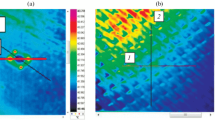Abstract
Polymethyl methacrylate (PMMA) and Polycarbonate (PC) are two famous optically clear thermoplastic polymers widely used in various aeronautical and astronatucial applications. Owing to their exceptional transparency, process shape adaptability, low density and high impact strength they find particular attention in aerospace industry where they are used to manufacture air craft canopies, windshields, impact resistant windows, visors and safety glasses. The design and manufacturing of the satisfied polymeric structures involve accurate modeling of the material behavior and detailed analysis of their service behavior under extreme loading conditions. In order to evaluate the material behavior under these loading conditions, extensive work in terms of experimental characterization and material constitutive modeling is required. A systematic research methodology including the material characterization, material constitutive modeling, constitutive model implementing and finite element prediction of mechanical behaviors is proposed in this work. The material characterization tests were performed by means of universal testing machine and Split Hopkinson pressure bar (SHPB) setup. On the basis of performed tests and using phenomenological approach, a constitutive model was proposed to successfully predict the entire deformation behavior of polymers under various loading conditions with sufficient accuracy. The model was implemented numerically by establishing a User-defined material subroutine (UMAT) in explicit Finite element (FE) solver LS-DYNA. The model successfully ascertained the dynamic behavior of PMMA based aircraft windshield and PC based astronaut helmet visor under application of high velocity projectile impact. A number of FE simulations were carried out to determine the critical impact energy, maximum deformation and stress level in these structures. The simulations results help to evaluate various design approaches to optimize the structural response prior to preliminary experimentations and therefore provide an alternative to costly and time consuming extensive experimental tests.
Similar content being viewed by others
References
W. R. Blumenthal, C. M. Cady, M. F. Lopez, G. T. Gray III and D. J. Idar, Influence of temperature and strain rate on the compressive behavior of PMMA and polycarbonate polymers, AIP Conference Proceedings, 620 (2002) 665.
M. F. Omar, H. M. Akil and Z. A. Ahmad, Measurement and prediction of compressive properties of polymers at high strain rate loading, Materials and Design, 32 (8) (2011) 4207–4215.
C. R. Siviour, S. M. Walley, W. G. Proud and J. E. Field, The high strain rate compressive behavior of polycarbonate and polyvinylidene difluoride, Polymer, 46 (26) (2005) 12546–12555.
E. M. Arruda, M. C. Boyce and R. Jayachandran, Effects of strain rate, temperature and thermo mechanical coupling on the finite strain deformation of glassy polymers, Mechanics of Materials, 19 (2) (1995) 193–212.
Z. Li and J. Lambros, Strain rate effects on the thermo mechanical behavior of polymers, International Journal of Solids and Structures, 38 (20) (2001) 3549–3562.
A. D. Drozdov, Modeling the nonlinear viscoelastic behavior of amorphous glassy polymers, Mathematical and Computer Modeling, 30 (5) (1999) 49–72.
J. Richeton, S. Ahzi, A. Makradi and K. S. Vecchio, Constitutive modeling of polymer materials at impact loading rates, Journal de Physique, IV (134) (2006) 103–107.
Z. P. Tang, Mechanical behavior of epoxy resin under high strain rates, Master’s Degree Thesis, University of Science and Technology of China (1981).
L. Wang, Foundations of stress waves, Elsevier (2007) 247–249.
Y. Duan, A. Saigal, R. Greif and M. A. Zimmerman, A uniform phenomenological constitutive model for glassy and semi crystalline polymers, Polymer Engineering Science, 41 (8) (2001) 1322–1328.
W. Chen, F. Lu and M. Cheng, Tension and compression tests of two polymers under quasi-static and dynamic loading, Polymer Testing, 21 (2) (2002) 113–121.
M. Jerabek, Z. Major and R. W. Lang, Uniaxial compression testing of polymeric materials, Polymer Testing, 29 (3) (2010) 302–309.
H. Kolsky, An investigation of the mechanical properties of materials at very high rates of loading, Proc. Phys. Soc. Lond B, 62 (1949) 676–701.
O. S. Lee and M. S. Kim, Dynamic material property characterization by using split Hopkinson pressure bar (SHPB) technique, Nuclear Engineering and Design, 226 (2) (2003) 119–125.
A. Samuelson and L. Sornas, Failure analysis of aircraft windshields subjected to bird impact, 15th ICAS Congress, London, UK (1986).
S. G. Zang, C. H. Wu, R. Y. Wang and J. R. Ma, Bird impact dynamic response analysis for windshield, J. Aeron. Mater., 20 (4) (2000) 41–5.
J. Wen, The nonlinear dynamic response analysis of the front windshield of Y12 under bird impact loads, Acta Aeron Astronaut Sinica (1990).
U. A. Dar, W. Zhang and Y. Xu, FE analysis of dynamic response of aircraft windshield against bird impact, International Journal of Aerospace Engineering, 171768 (2013) 1–12.
U. A. Dar, W. H. Zhang and Y. J. Xu, Numerical implementation of strain rate dependent thermo viscoelastic constitutive relation to simulate the mechanical behavior of PMMA, International Journal of Mechanics and Materials in Design, 10 (1) (2014) 93–107.
Author information
Authors and Affiliations
Corresponding author
Additional information
Recommended by Associate Editor Kyeongsik Woo
Uzair Ahmed Dar is Ph.D. graduate in Aeronautical and Astronautical Manufacturing Engineering Department from Northwestern Polytechnical University, Xi’an, China. His research interests include constitutive material modeling, dynamic response analysis, structural design, finite element analysis, computational fracture mechanics, static and dynamic simulations of aerospace structural components.
Rights and permissions
About this article
Cite this article
Dar, U.A., Zhang, W. Polymer based aerospace structures under high velocity impact applications; experimental, constitutive and finite element analysis. J Mech Sci Technol 29, 4259–4265 (2015). https://doi.org/10.1007/s12206-015-0922-3
Received:
Revised:
Accepted:
Published:
Issue Date:
DOI: https://doi.org/10.1007/s12206-015-0922-3




